Benin, a country in West Africa, is home to a wide variety of bird species. With its diverse ecosystems, including forests, savannas, wetlands, and coastal regions, Benin’s avian diversity is well suited to a wide range of habitats.
The country’s birdlife is of particular interest to ornithologists and bird enthusiasts who seek to explore this hidden gem of bird biodiversity. From the African fish eagle to the yellow-billed kite, Benin is home to some of the most spectacular and unique bird species in the world.
In this article, we will explore the fascinating world of birds in Benin, their ecological importance, and some of the challenges these birds face in the 21st century.
1. Woodland Kingfisher
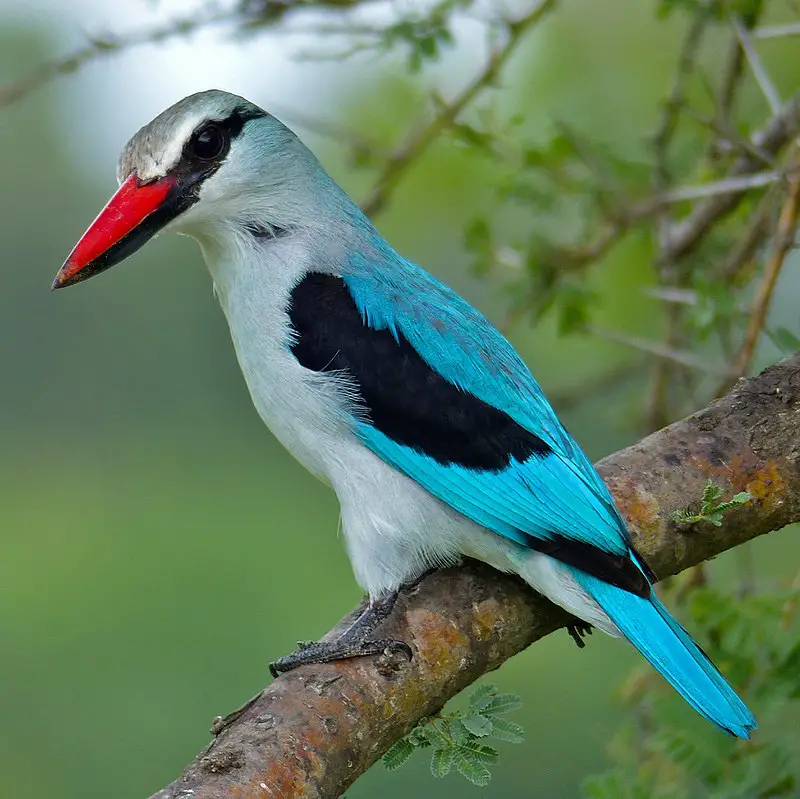
The Woodland Kingfisher is a beautiful bird, native to Africa south of the Sahara. It was first described in 1766 by Carl Linnaeus who called it Alcedo senegalensis.
This tree kingfisher has an attractive blue and white plumage with some red and black markings on its wings, tail, and head.
The male also has a bright orange beak which helps to distinguish him from the female whose beak is yellowish-green.
These birds can usually be found in wooded areas near water sources such as rivers or lakes where they hunt for food including fish, frogs, small insects, and even lizards.
They build their nests either high up in trees or inside holes dug out of banks near rivers and ponds.
Although not threatened yet, these lovely creatures need our protection so that future generations will have the chance to marvel at them too.
Scientific classification:
| Kingdom | Animalia |
| Phylum | Chordata |
| Class | Aves |
| Order | Coraciiformes |
| Family | Alcedinidae |
| Subfamily | Halcyoninae |
| Genus | Halcyon |
| Species | H. senegalensis |
Also Featured In: Common Nigerian Birds, Birds You’ll Find in Kenya Safari
2. Abyssinian Roller
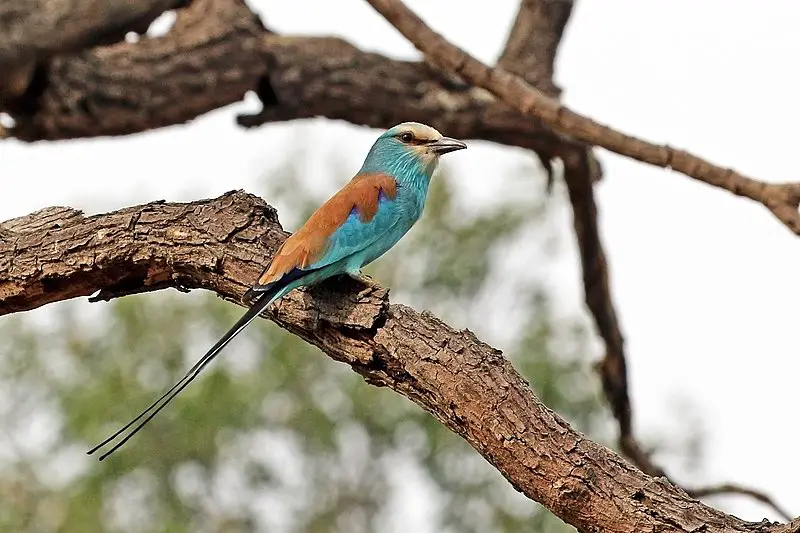
The Abyssinian roller is a large bird, nearly 28 cm in length. It has an unmistakable plumage of bright blue upperparts with chestnut underparts and wings.
Its head is blackish-blue and its tail feathers are white tipped giving it a striking appearance when seen in flight.
This species breeds across tropical Africa from the Sahel belt south of the Sahara desert to East Africa.
Northern populations tend to migrate short distances after the wet season while southern ones stay resident throughout the year.
They feed mainly on insects which they catch by hovering over fields or open woodland before diving down onto their prey below them.
In addition, they also eat small reptiles, amphibians, and rodents along with fruits such as figs occasionally too.
Scientific classification:
| Kingdom | Animalia |
| Phylum | Chordata |
| Class | Aves |
| Order | Coraciiformes |
| Family | Coraciidae |
| Genus | Coracias |
| Species | C. abyssinicus |
3. Double-Spurred Spurfowl
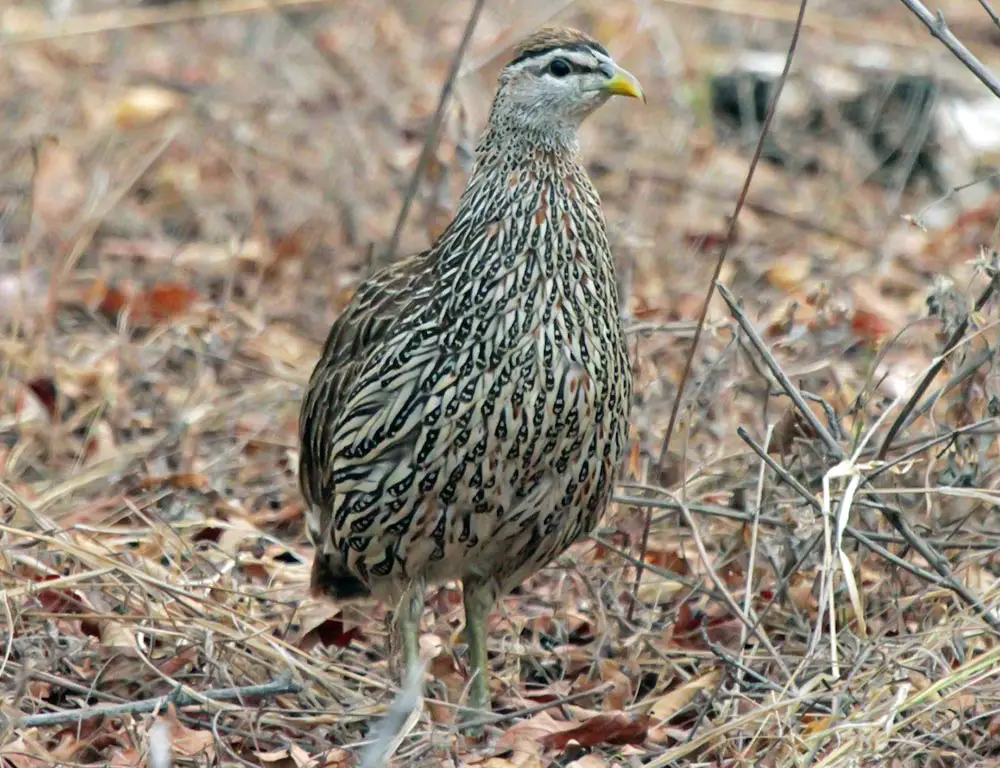
The Double-spurred Spurfowl is a gamebird of the Phasianidae family and belongs to the order Galliformes. It can be found in tropical West Africa, as well as an isolated population in Morocco which is decreasing due to human activity.
In 1760 Mathurin Jacques Brisson described it for the first time with its distinctive double spurs on each leg used during mating displays.
The bird has overall brown coloration but features black stripes along its sides and chest while having white spots scattered across feathers too.
Its legs are long and thick enabling them to run quickly when escaping predators or searching for food such as insects, seeds, or fruits that make up their diet.
These birds form monogamous pairs who defend territories fiercely against intruders all year round whether other spurfowls or humans encroaching into their habitats directly threatening conservation efforts being made by organisations around the world today.
Scientific classification:
| Kingdom | Animalia |
| Phylum | Chordata |
| Class | Aves |
| Order | Galliformes |
| Family | Phasianidae |
| Genus | Pternistis |
| Species | P. bicalcaratus |
4. African Grey Woodpecker
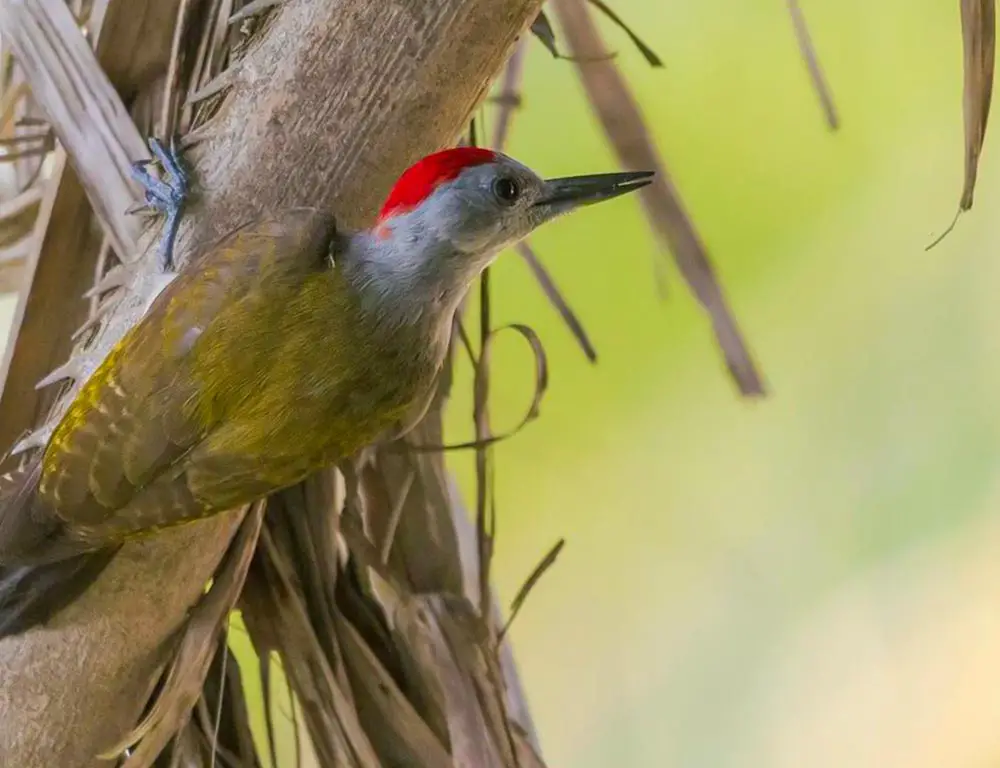
The African Grey Woodpecker is a species of bird found in Sub-Saharan and Equatorial Africa. This bird resides mainly in forest and bush habitats, building its nest inside tree holes using oil palm material to lay two to four eggs.
It’s a common species with an extensive range that stretches across the continent, making it of Least Concern according to the International Union for Conservation of Nature (IUCN).
This woodpecker feeds largely on insects like ants, termites, and beetles which are excavated from dead or decaying trees by drilling into them with their beaks.
They can also feed on fruits when they become available during certain times of the year.
The African Grey Woodpecker is known as one of Africa’s most beautiful birds due to its stunning gray plumage featuring white scalloping along its back and wings contrasted against black tail feathers.
Scientific classification:
| Kingdom | Animalia |
| Phylum | Chordata |
| Class | Aves |
| Order | Piciformes |
| Family | Picidae |
| Genus | Dendropicos |
| Species | D. goertae |
5. Brown-Throated Wattle-Eye
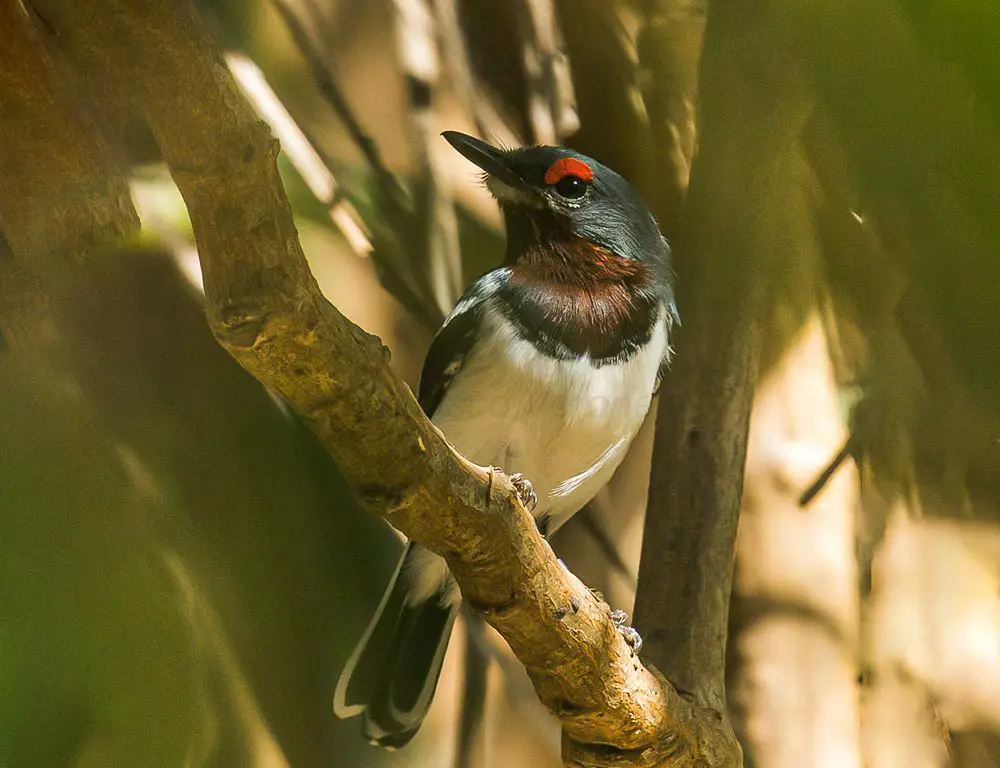
The Brown-throated Wattle-eye is a small and insectivorous passerine bird belonging to the family of Muscicapidae. It usually lives in tropical Africa, being found mainly in western, central, and northeast regions.
As it has an eye-catching scarlet spectacled face, this species can be easily spotted due to its bright colors. Its diet consists mostly of insects but also eats some fruits or even nectar from flowers when available.
This species is known for its fast movements as they are good fliers that quickly switch between tree branches looking for food or shelter during rainy days.
They build their nests close to each other providing them with safety against predators thanks to their flock behavior which makes them one beautiful sight to observe.
Scientific classification:
| Kingdom | Animalia |
| Phylum | Chordata |
| Class | Aves |
| Order | Passeriformes |
| Family | Platysteiridae |
| Genus | Platysteira |
| Species | P. cyanea |
Also Featured In: Common Birds of Democratic Republic of the Congo,
6. Senegal Coucal
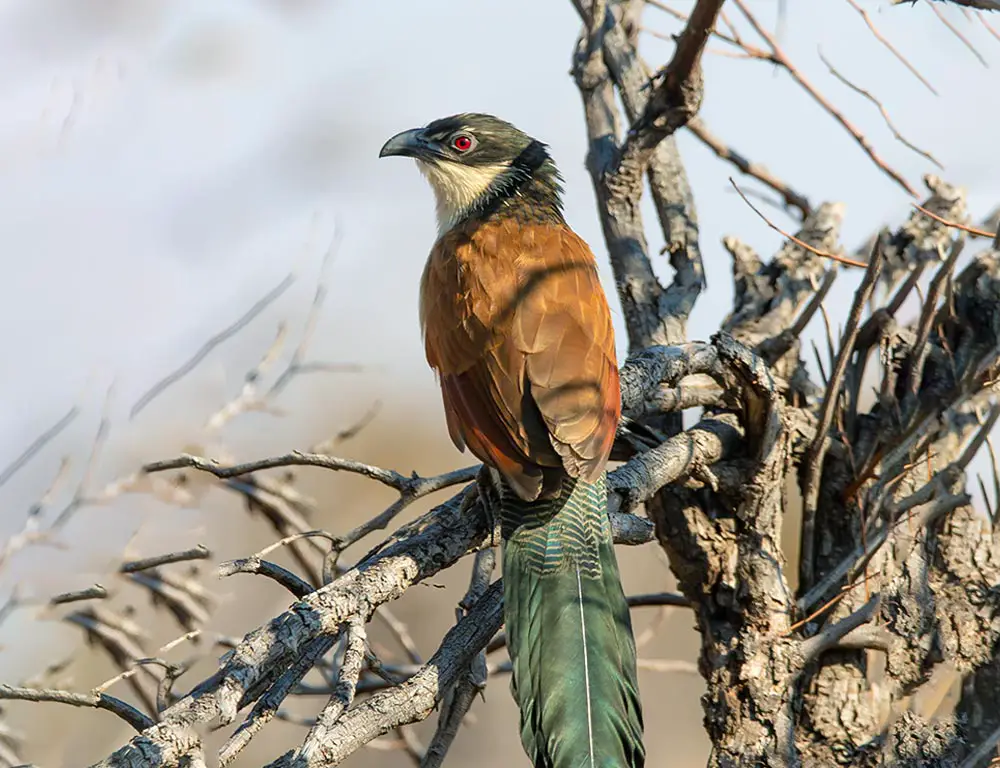
The Senegal coucal is a cuckoo-like bird native to Central and Southern Africa. It has a medium-sized body with black wings, a tail, and a head along with white breast feathers.
Its natural habitat consists of lightly wooded savannahs where it feeds on insects, small reptiles, amphibians, and fruits.
This species can be found in pairs or alone atop low bushes searching for prey or perched up high singing its distinctive song that features a mix of harsh notes as well as melodic ones.
The Senegal council enjoys the sun’s rays but also loves sheltering in dense vegetation when danger arises nearby.
Overall this beautiful bird makes an interesting addition to any backyard garden.
Scientific classification:
| Kingdom | Animalia |
| Phylum | Chordata |
| Class | Aves |
| Order | Cuculiformes |
| Family | Cuculidae |
| Genus | Centropus |
| Species | C. senegalensis |
Also Featured In: Common Kenyan Birds, Birds that You’ll Find in Kruger national park
7. Denham’s Bustard
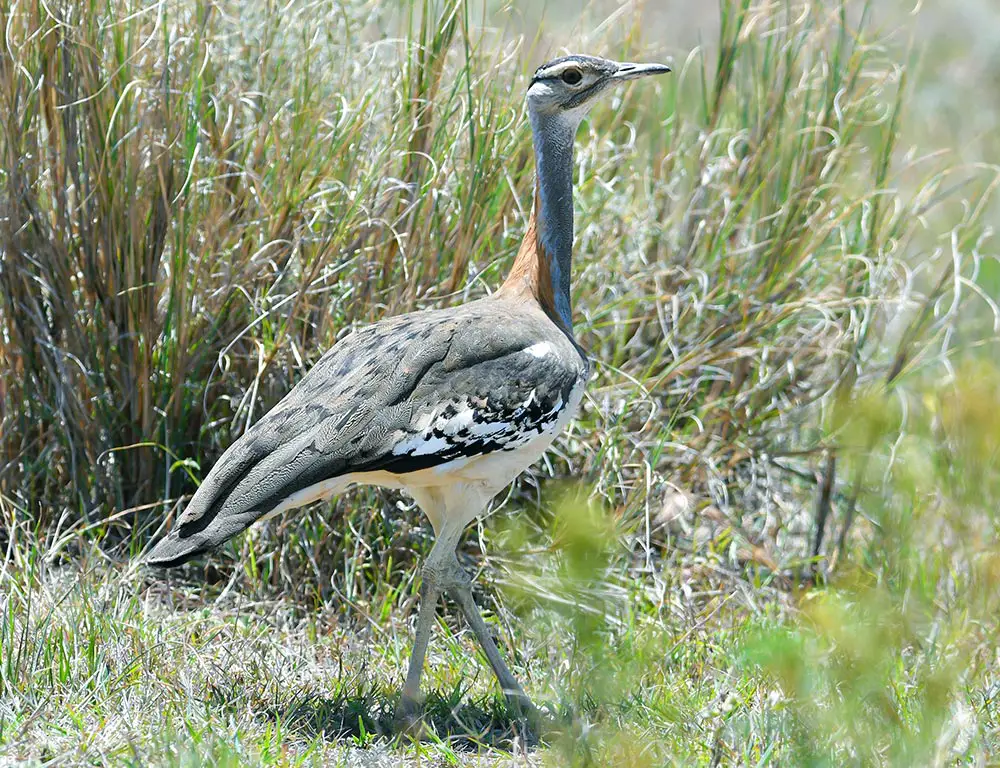
Denham’s bustard is a large bird belonging to the Bustard family found in Sub-Saharan Africa. It inhabits open ground including agricultural land, grassland, and floodplains.
This species is resident but some inland populations move down south during the winter season for better climate conditions.
The common names used for this species are dedicated to an English explorer called Stanley who first discovered it in 1841 while traveling across the Central African Republic region.
Denham’s bustards have strong legs which help them take off quickly from the ground due to their heavy body weight of 2–3 kgs on average with wingspan ranging up to 140 cm long.
They feed mostly on insects, rodents, and seeds making them omnivorous birds.
These birds usually live solitary lives or form small flocks when migrating but come together during breeding seasons as they build their nests close to each other and mate around the same period too.
Scientific classification:
| Kingdom | Animalia |
| Phylum | Chordata |
| Class | Aves |
| Order | Otidiformes |
| Family | Otididae |
| Genus | Neotis |
| Species | N. denhami |
Also Featured In: Most Unique Birds in Niger,
8. Pearl-Spotted Owlet
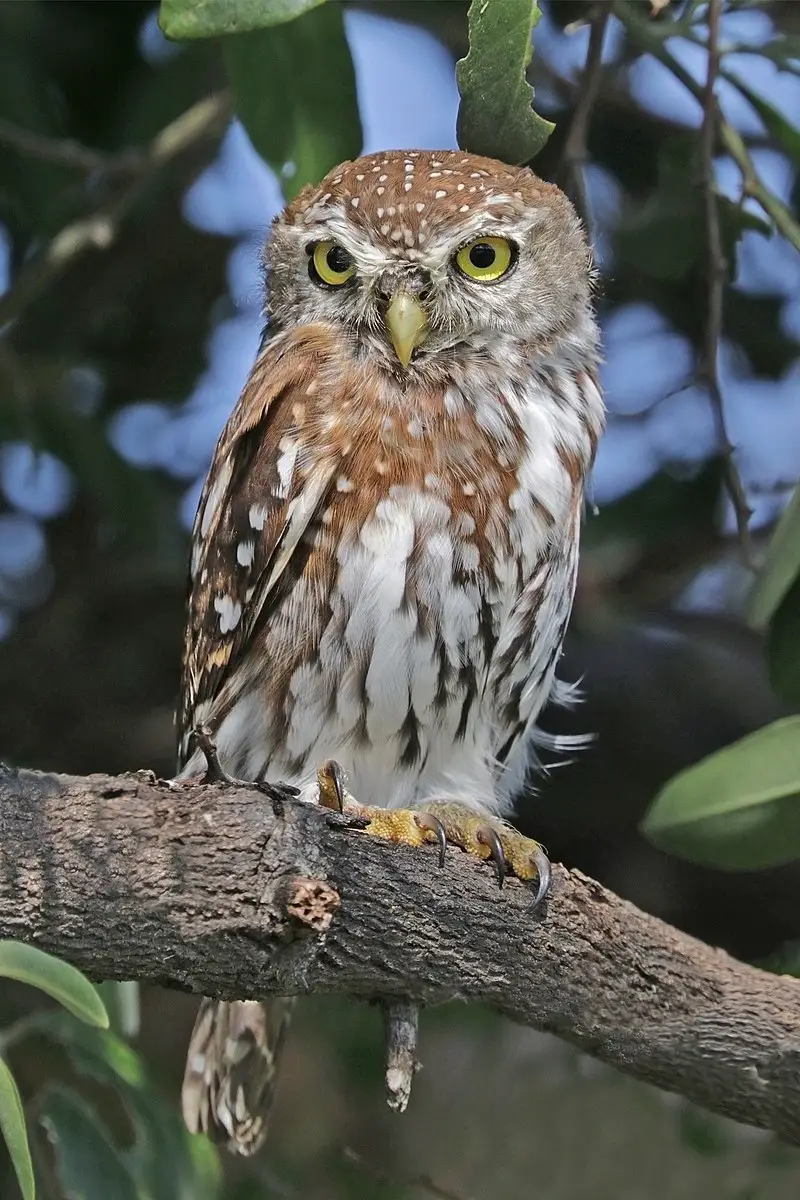
The Pearl-spotted Owlet is a small bird of prey that lives in sub-Saharan Africa. It belongs to the Strigidae family, which are commonly referred to as typical owls or true owls.
These birds have brown feathers with heavy spots, making them easily recognizable among other species of owl.
They usually measure between 14 and 16 centimeters long with an average wingspan of 28 centimeters wide.
Their diet consists mainly of insects such as moths and beetles but they also feed on frogs and small rodents occasionally.
During mating season males will use their sharp call for territorial purposes while females remain silent during this period.
The female lays 2-4 eggs at one time before incubating them for around 3 weeks until hatching occurs after which both parents take part in feeding their young chicks until fledging age which is when they become independent enough to survive on their own.
Scientific classification:
| Kingdom | Animalia |
| Phylum | Chordata |
| Class | Aves |
| Order | Strigiformes |
| Family | Strigidae |
| Genus | Glaucidium |
| Species | G. perlatum |
9. Yellow-Crowned Gonolek
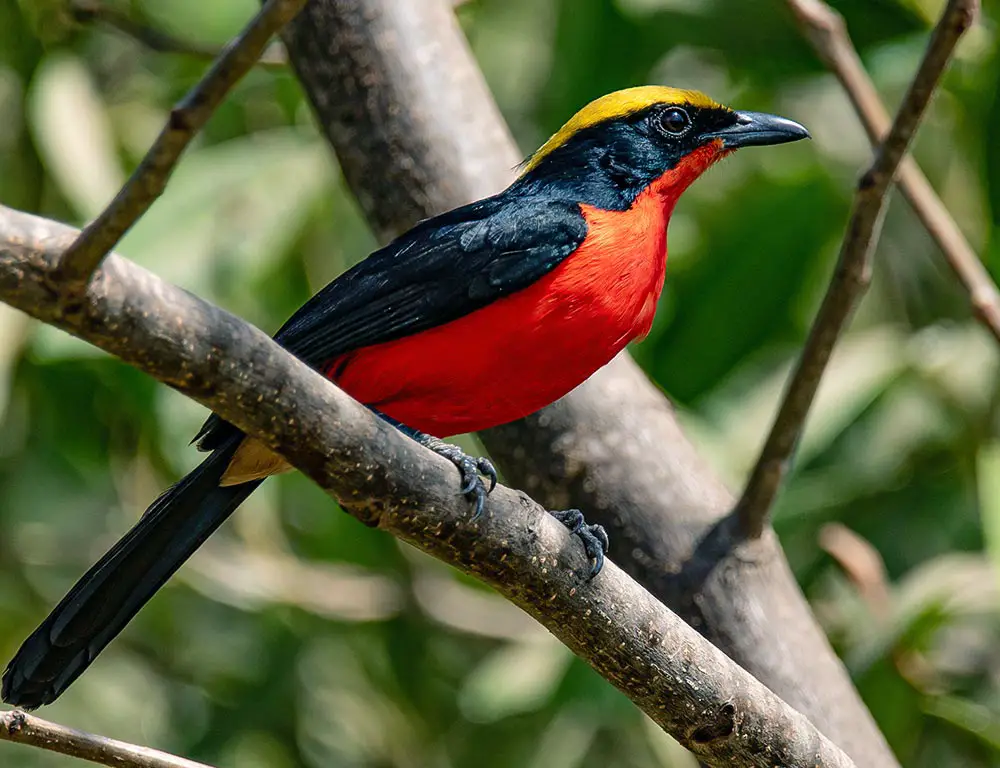
The Yellow-crowned Gonolek is a common resident bird of equatorial Africa, found from Senegal to Ethiopia. It lives in dense undergrowth and wooded habitats, typically nesting in cup structures within bushes or trees.
This medium-sized passerine has striking plumage consisting of black wings with white spots, a yellowish crown, nape, brown body feathers streaked with cream markings, and orange legs.
Its diet consists mainly of insects such as grasshoppers and caterpillars which it hunts by scanning the ground while perched on branches or flying low over vegetation searching for prey items.
The call of this species is an unmistakable loud “weeoo” often heard early morning when they are most active.
These birds form monogamous pairs that breed year round depending upon environmental conditions resulting in clutches containing up to five eggs being laid each season.
Scientific classification:
| Kingdom | Animalia |
| Phylum | Chordata |
| Class | Aves |
| Order | Passeriformes |
| Family | Malaconotidae |
| Genus | Laniarius |
| Species | L. barbarus |
10. Western Reef Heron
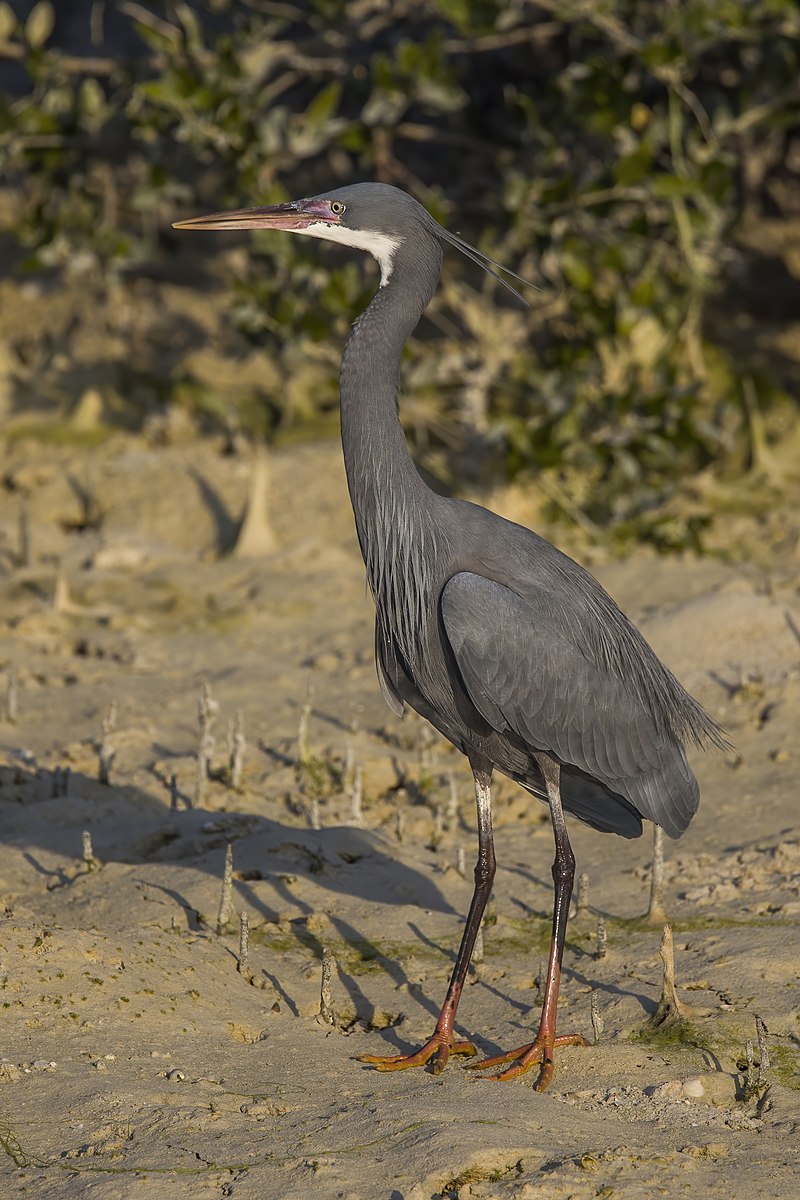
The western reef heron, also known as the western reef egret, is a medium-sized bird found in southern Europe, Africa, and some parts of Asia. It usually inhabits coastal areas and has two distinctive plumage forms.
The slaty-grey form can be mistaken for the rare dark morph of the Little Egret while its white form looks similar to that of an immature Grey Heron.
This species feeds mainly on fish but will occasionally eat insects or other small aquatic animals like crabs and molluscs too.
Western Reef Herons are solitary birds that nest near water bodies where they build nests from sticks which may sometimes contain feathers or seaweed as well.
They have become endangered since their habitats have been destroyed due to human activities such as building developments along coastlines; however, conservation efforts are being taken to ensure their survival for future generations.
Scientific classification:
| Kingdom | Animalia |
| Phylum | Chordata |
| Class | Aves |
| Order | Pelecaniformes |
| Family | Ardeidae |
| Genus | Egretta |
| Species | E. gularis |
Also Featured In: Birds of Senegal, Birds of Karnataka
11. Spotted Thick-Knee
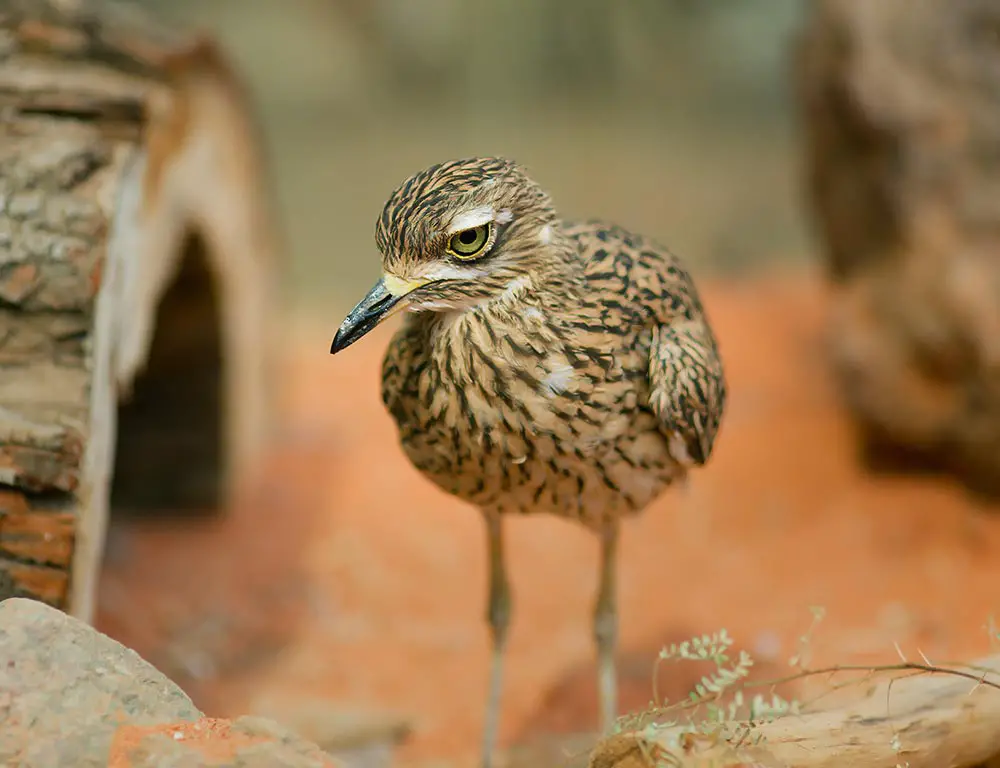
The spotted thick-knee is a wader in the family Burhinidae, native to tropical regions of central and southern Africa.
It stands at 45.5 cm tall with long legs, and brown and white speckled plumage that provides excellent camouflage amongst grasslands or other similar habitats.
This species feeds mainly on insects but can also be found eating small reptiles and amphibians as well as some fruit when available.
They are nocturnal creatures who spend their days hidden away from predators in dense vegetation waiting for nightfall before venturing out to hunt for food.
The breeding season takes place between October to February during which time pairs form monogamous relationships lasting up until the next nesting period begins again each year.
This bird has an incredible ability to remain undetected by its predators allowing it to thrive despite its vulnerable nature making it an important part of many African ecosystems today.
Scientific classification:
| Kingdom | Animalia |
| Phylum | Chordata |
| Class | Aves |
| Order | Charadriiformes |
| Family | Burhinidae |
| Genus | Burhinus |
| Species | B. capensis |
Also Featured In: Oman Birds, Birds You’ll Find in Zoo
12. Black-Crowned Tchagra
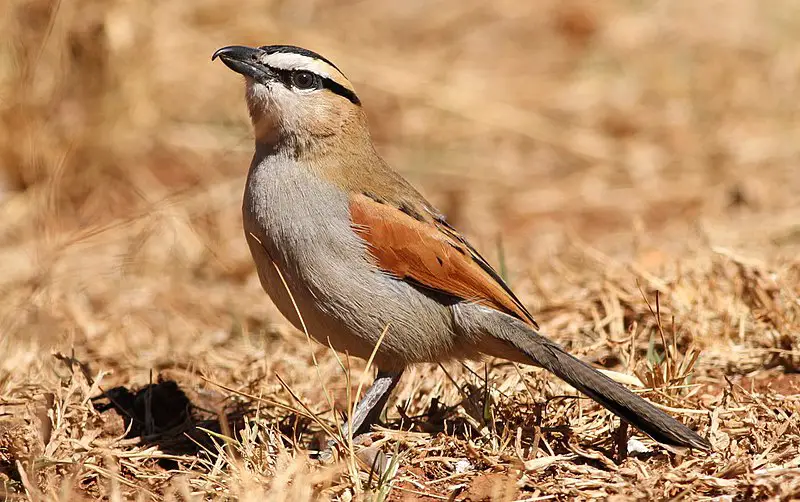
The Black-crowned Tchagra is a bushshrike found in the Arabian peninsula and most of Africa. It inhabits scrub, open woodland, semi-desert, and cultivation areas.
This species has distinctive black crown feathers on its head with brown wings and tails that have white stripes running through them.
Its breast is mottled greyish-brown while its throat and belly are off-white or pale yellow in coloring making for an attractive bird to behold.
The French zoologist Mathurin Jacques Brisson first described this bird back in 1760 as part of his encyclopedic ornithological work ‘Oiseaux’ (Birds).
Whether you live near the Sahara Desert or not, it can be fun to observe these birds during their active times so keep your eyes peeled.
Scientific classification:
| Kingdom | Animalia |
| Phylum | Chordata |
| Class | Aves |
| Order | Passeriformes |
| Family | Malaconotidae |
| Genus | Tchagra |
| Species | T. senegalus |
Also Featured In: Gambia birds, Common Algerian Birds
13. Grey Pratincole
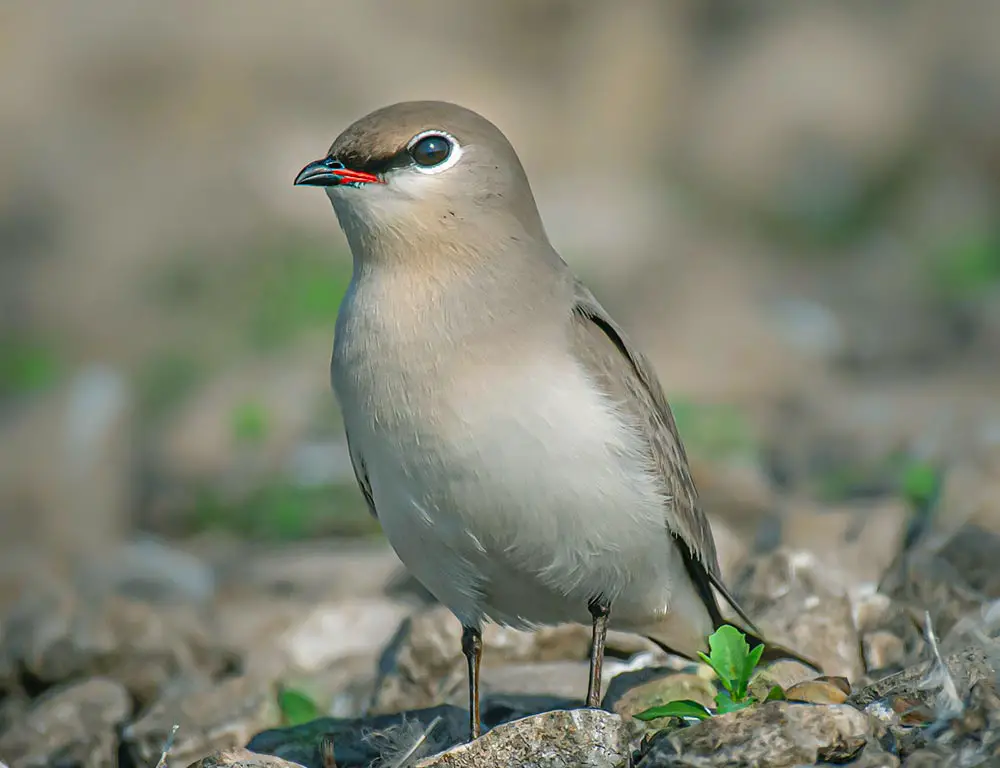
The grey pratincole is a bird species belonging to the Glareolidae family, found in Africa. It inhabits various countries such as Angola, Cameroon, and Ghana, among others.
This bird has grey plumage and distinctive long wings, which make it an excellent flier. It is also an insectivorous bird and feeds mainly on insects such as grasshoppers and beetles.
The grey pratincole is known for its beautiful aerial acrobatics and can often be seen flying low over water surfaces, picking insects on the fly.
This bird species is highly migratory and moves seasonally to different parts of Africa in search of food and breeding sites.
Despite facing various threats, such as habitat loss and hunting, the grey pratincole population remains stable, and it is currently classified as a species of least concern.
Scientific classification:
| Kingdom | Animalia |
| Phylum | Chordata |
| Class | Aves |
| Order | Charadriiformes |
| Family | Glareolidae |
| Genus | Glareola |
| Species | G. cinerea |
14. Western Plantain-Eater

The Western plantain-eater bird is a member of the turaco family, found in tropical West Africa. They live in open woodland habitats and are known to be noisy and conspicuous.
With their large size, they lay two or three eggs in tree platform nests during breeding season. They are also called the gray plantain-eater or western gray plantain-eater and are a resident breeding species of Africa.
The Western plantain-eater is arboreal and nearly passerine, making them a unique species to observe in their natural habitat.
It’s interesting to note that they are common in their range, proving to be a vital species of bird within the African ecosystem.
As a colorful and distinct bird, the Western plantain-eater is appreciated by many bird watchers and nature enthusiasts.
Scientific classification:
| Kingdom | Animalia |
| Phylum | Chordata |
| Class | Aves |
| Order | Musophagiformes |
| Family | Musophagidae |
| Genus | Crinifer |
| Species | C. piscator |
To Recap
Benin is home to a diverse range of 14 bird species, each contributing to the country’s rich avian tapestry. From the vibrant Northern Carmine Bee-eater to the iconic African Fish Eagle, these birds reflect the ecological diversity found within Benin’s landscapes.
As we continue to appreciate and protect these avian inhabitants and their habitats, we also recognize the importance of preserving the broader biodiversity of this West African nation.
By valuing and conserving the natural environment, Benin can ensure that these birds and the ecosystems they rely on thrive for generations to come, contributing to a sustainable and vibrant natural heritage.